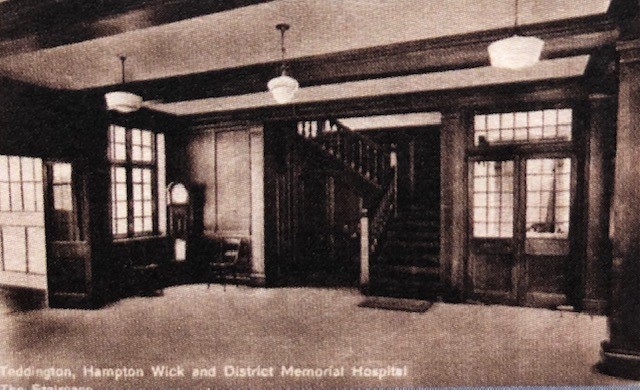The fascinating history of Teddington Memorial Hospital before its transfer to the NHS is one of Teddington’s success stories. On your next visit to the hospital, look at the historical timeline on display in the hospital corridors. The exhibition is a permanent reminder of the history of the hospital and the many achievements of The Friends of TMH. Since its establishment, the hospital has been a highly valued facility much needed and supported by the local community.
Founded as a hospital for poor and needy of Teddington
In 1875 Elfin Grove Villas was given by Thomas Chappell (of the piano firm) for a hospital for the poor and destitute of Teddington. It had 4 beds, and patients paid 1 shilling a day (5p). Money was raised by annual subscriptions, donations, bazaars, fetes, concerts, and theatrical performances. According to annual reports, from 1875 to 1924, an impressive 12,731 patients were treated at the hospital.
24 hospital beds too few in 1914
In 1914 the number of beds was increased to 24. But within a short time, the site became too small for the growing population of Teddington. The existing building was without room for expansion, so other sites were sought.
The Medical Committee began to look for possible sites in 1919 where a new hospital and health centre could be built. The hospital was planned as a living war memorial with a commemorative obelisk outside.
The present TMH site was acquired for £2,000 from Messrs R & D Anderson. A family member generously gave a donation to the building fund of £1,000.
Swan and Stag’s 1920s fundraising
From 1924 to 1934, the money to build a new hospital was raised entirely by voluntary and charitable efforts.
One fundraising method was via the Swan & Stag Volumes. This is a collection of magazines that were published annually in aid of the hospital fund. These are now held at Twickenham Library. Hence the Swan and Stag became the Memorial Hospital’s emblem in the 1920s/30s.
In 1928 Lord Dawson of Penn (the Royal Physician) laid the foundation stone embedded in the side return wall by the hospital’s front door. Buried at the back can be found the names of benefactors and donors.
The ground at the back of the hospital was utilised for a hospital kitchen garden. This was where fresh fruit and vegetables were grown and used for patient and staff meals.
1930s hospital expansion with war looming
In 1933 an Operating Theatre was built as a memorial to Dr I Coalbank, a well-known local GP, followed by a Children’s Ward and single rooms for Private Patients.
In 1939 the hospital became a Casualty Clearing Station with 40 beds for wartime emergencies. A bomb blast wall was built at the front. This saved the hospital from severe damage when the church opposite received a direct hit.
Today, you can still see part of the original 1930s wooden interior in the hospital lobby.
National Health Service significant milestone
1948 was an important milestone for the hospital. It was taken over by the newly created National Health Service, and in 1954 the League of Friends of Teddington Memorial Hospital was formed.
The Teddington community has a long tradition of generosity and support for the hospital, which continues today.
The Friends of Teddington Memorial Hospital has a proud history of supporting the hospital and ensuring that it continues to be at the heart of our local community.
How can you help
There are numerous ways to get involved with The Friends and support Teddington Memorial Hospital.
One of the easiest ways is to simply make a one-off donation using the Donate button on this page or tap the contactless donation point to give £3.00, or an amount of your choosing.
Alternatively, you may wish to become a Member of The Friends.
If you would like to be more actively involved, become a volunteer. Our volunteers help in the League of Friends shop in the hospital, fund-raising activities, and local community events. Volunteers play an essential role in enabling The Friends to maintain its services within the hospital.
To find out more, click volunteering.

